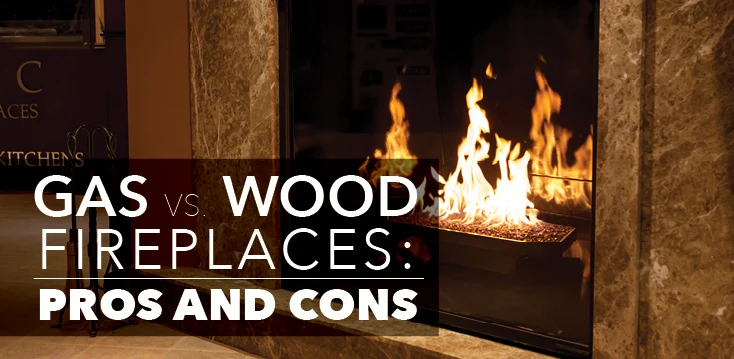Gas vs Wood Fireplace: Pros and Cons

Are your fingers and toes persistently cold during winter? Warming up in front of a roaring fireplace helps! But which type is better, a traditional wood fireplace or a modern gas fireplace? Compare the pros and cons to help you decide.
Ease of Use
Building a fire in your wood-burning fireplace is quite a task. You need to gather wood and kindling, arrange it properly, light the fire, and maintain it to keep it burning. And if you’re out of wood, no fire for you!
A gas fireplace is as easy to use a flipping a light switch. In fact, most gas fireplaces turn on this way. Others have built-in thermostats, turning on and off automatically to maintain a set temperature in the room. When you’re done using the fireplace, simply flip the switch back off and go about your day.
Winner: Gas fireplace
The Experience
Yes, gas fireplaces produce heat, but there’s no snap and crackle, no stoking the fire, no aroma from a Yule log. Gas fireplaces are also often plagued with unattractive blue flames. For a genuine old-fashioned fire-burning experience, nothing beats real wood.
Winner: Wood fireplace
Maintenance
The soot, ash, and burned logs that remain after a wood-burning fire goes out are not fun to clean up. The job is messy and requires great care. You also need to have the chimney professionally cleaned once a year to remove creosote buildup. This highly flammable byproduct of wood-burning fires can pose a safety hazard if you don’t remove the buildup annually.
Gas fireplaces require no effort to maintain. They produce no soot, ash, or creosote, so no messy cleanup or sweeping is necessary. Still, you may want to have a professional take a look at your gas fireplace each fall when you schedule furnace maintenance to ensure safe, proper operation.
Winner: Gas fireplace
Cost Effectiveness
The cost to operate a wood fireplace depends on where you get your wood. If you live in a forested area with access to free firewood, you can heat your home at no cost. However, if you live in a suburban setting, you’ll probably need to purchase wood from a vendor or store. When a fire isn’t lit, be sure to close the damper or the chimney will let cold air enter from outside.
Natural gas is a relatively cheap fuel. If you already have gas lines hooked up to your home, a gas fireplace isn’t expensive to operate. Keep in mind that just like older gas furnaces, some gas fireplaces feature a continuously lit pilot light. This consumes a bit of fuel and adds to your costs.
Winner: It depends
Safety
You should learn how to properly use your wood fireplace before you attempt to light a fire. The damper must be open while the fire burns or smoke will pour into your home. You should also keep a metal grate in front of the fire to catch potential flying embers that could start a fire. Careful ash disposal and creosote cleanup are also necessary to reduce fire risk.
A gas fireplace is a combustion appliance, meaning it produces carbon monoxide the could enter your home if something blocks the vent. The fuel line could also develop a leak and allow natural gas to enter your home. Fortunately, these problems are rare, and yearly inspections are enough to put your mind at ease.
Winner: Gas fireplace
Clearly, a gas fireplace is the way to go if ease of use, low maintenance, and safety are your top priorities. To schedule gas fireplace installation, conversion, or repair, please contact Aire Serv® today.
 Click to call
Click to call


